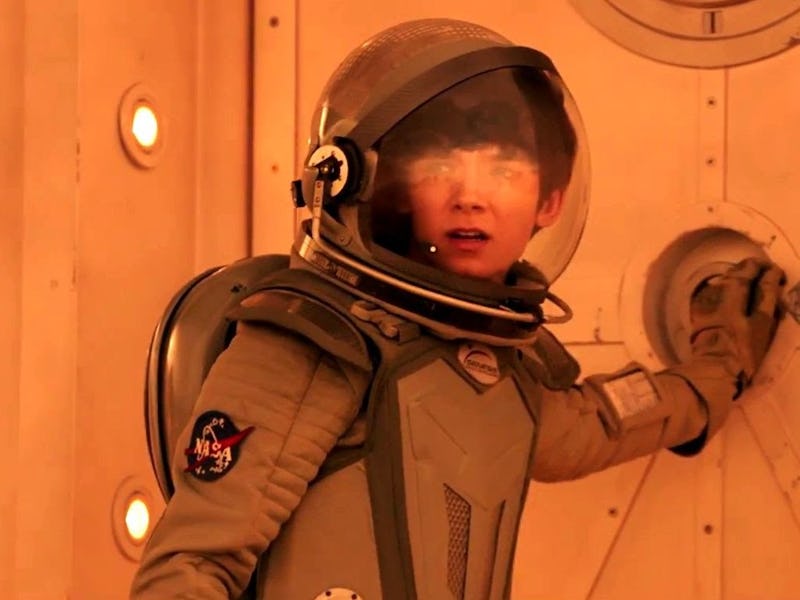What 'The Space Between Us' Gets Right and Wrong
The movie tackles some pressing space health questions, from pregnancy in space to heart troubles.

Let’s make one thing clear up front: The Space Between Us is not a great movie. It takes a pretty interesting concept — a baby born in the future and raised on a colony on Mars — and somehow veers it into a boring story about a tweenage romance.
Unlike many science fiction movies, however, The Space Between Us meanders into some real science, with an honest gravitational premise: Both space and Mars are represented as adhering to actual microgravity parameters one would expect (near zero-gravity on the way to Mars, and one-third once there). Spoilers ahead.
Heart Conditions
When our 16-year-old protagonist arrives on Earth, he finds himself suddenly suffering from a bad heart. There’s nothing really unusual about that microgravity can decrease the amount of blood in the body, which means there’s less blood pumping through the heart. As a result, the heart starts to soften up and round out, in turn decreasing overall blood pressure.
The movie explains this by saying Elliott is experiencing heightened levels of troponin, a protein complex which is essential for muscle contraction. Troponin also acts as a marker for heart muscle cell death — increased levels circulating in the blood basically mean there’s been injury cardiac muscle. While things are much more nuanced than simply saying high troponin is bad (different elevated forms of troponin will be signs of different kinds of cardiac conditions), increased troponin on the whole is a pretty clear indicator that something is wrong with the heart. Although sloppy and a bit vague, it would not be wrong to say a heart accustomed to Martian gravity would have trouble acclimating to the increased gravity of Earth — and that this would be supported by finding more troponin circulating in the body.
Poor Bone Density
Bones lose density in microgravity. With less stress exerted on the body thanks to increased weightlessness, bones don’t need to exert as much energy to reinforce themselves with new cells. In fact, bone cells — specifically, your osteoblasts — stop synthesizing as much bone matter as before.
Most astronauts lose about one percent of their original bone mass, which still results in increased brittleness. After returning to Earth, an astronaut’s bones are more prone to breaking under intense stress (like heavy lifting, which doesn’t really occur in space since you can move any object with a single soft touch).
Would living 16 years in Martian gravity actually lead to the type of brittleness that would make Earthly-bound osteoporosis seem comparatively like a light bruise? We don’t know for sure — no one has ever lived in microgravity long enough where the body has skated by with such weak bones. But it’s not unthinkable that someone like Elliott, born on Mars, would need some sort of major intervention to withstand the gravitational change upon arriving on Earth. The movie accounts for this realistically by giving Elliott a surgical casing for his bones to acclimate to the change in gravity and prevent his bones from shattering.
Would a mesh-like casing really work? Would it be feasible to graft that onto someone’s bones? That’s even more unclear. The movie makes no effort to explain it; to be fair, scientists haven’t thought that far into the future yet themselves.
Pregnancy in space
Possibly the most urgent space-related question that persists throughout the movie is about whether a pregnancy can survive outer space. Elliott’s mother just happens to find out en route to Mars that she is about three months pregnant. She goes into labor after landing on the red planet. We’re left with one major question: Can a pregnancy survive space?
We’re not really sure: Pregnancy is expressly forbidden by all nations currently sending astronauts into space. We have no idea what the effects might be. A fetus might withstand the journey and be completely fine, or it could encounter a host of dangerous issues.
Everything we know about pregnancy in space comes down to rats. The closest data we have is a 1983 USSR satellite launched into space, with a pregnant rat on board who suffered worse than the fetuses. When the rat pups were born after the satellite was brought back to Earth, they were only slightly thinner and weaker than their Earth-based counterparts and lagged behind a bit in their mental development although they eventually caught up.
The mother rat, on the other hand, lost a quarter of her original body weight, and was afflicted with severe changes in her hormonal and endocrine systems, which regulate bodily functions.
A more recent study by NASA sent 20 pregnant rats into space, but these mothers and babies withstood spaceflight rigors with much more ease. The mothers, despite muscle loss from microgravity, bounced back pretty well. The babies had noticeable problems with their vestibular systems (which regulates balance and coordination as affected by the inner ear). They managed to get back to normal in a matter of days, however.
But it’s wrong to use these results to speculate how pregnant humans will fare. We simply have too little data to make that determination.